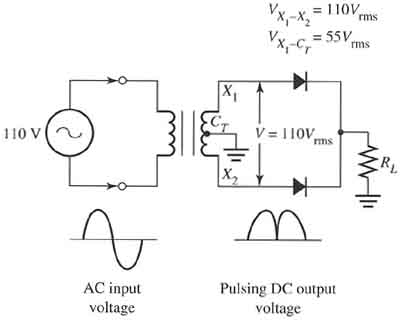AMAZON multi-meters discounts AMAZON oscilloscope discounts
A drawback of the single-diode half-wave rectifier is that it only produces a half-wave dc output. If a second diode is added to this circuit and a center-tapped transformer is used, the output waveform will be two positive half-waves. The first diode provides an output half-wave when the supply voltage is between 0° and 180°. and second half-wave output is provided by the second diode when the supply voltage is between 180° and 360°. Fig. 1 shows the electrical diagram of the two-diode full-wave bridge circuit. This diagram also shows the sine wave for the single-phase input voltage and the waveform of the two positive half-waves for the output.

Above: Fig. 1 Electronic schematic of a two-diode bridge rectifier
circuit. The waveforms for the ac sine wave at the input and the two half-waves
at the output are also shown.
The transformer for this circuit is the same transformer from the previous circuit and it will produce output voltage from a two-diode rectifier with a center-tap transformer that will be approximately the same voltage as the output of the single-diode rectifier. At first it may appear that the circuit with the center tap transformer will provide more output voltage since it has two diodes, but notice that since the secondary windings of each transformer are equal, the voltage from each half of the center-tap transformer (X1 to CT) will be half the voltage between X1-X2. This means that the voltage from each half of the transformer will be added together to provide approximately the same dc average voltage at the output of the circuit as the output voltage from the single-diode rectifier.
The equation for calculating the dc average voltage for the two-diode full-wave bridge rectifier is found in two steps after the peak secondary voltage is determined. Notice that since this is a center-tap transformer, the Vout peak can be calculated either of two ways using X1-X2 as the full secondary voltage divided by 2, or using X1-CT as the amount of voltage for half the transformer. Be sure the voltage drop for each diode is subtracted from secondary voltage.
Vout peak = 1.414 x (Vsecondary (X1-X2))/2) - 0.7 Vsecondary (X1-X2))
or
Vout peak =1.414 x (Vsecondary (X1-CT))) - 0.7 V
Next calculate the dc average voltage from the equation. Note that since there are now two diodes in the circuit, the output voltage will include voltage from both half-waves, so the new formula will show two times the peak voltage.
V dc av = 2VP/π (where VP is Vout (peak) from either of the previous equations)
Exercise
Calculate the V dc av voltage for a two-diode full-wave rectifier that uses a center-tap transformer. The secondary voltage is 110 volts ac rms as measured between X1 and X2 just like the single-diode rectifier circuit, and the voltage from X1 to the CT is 55 volts. (Be sure to include the 0.7 volt drop for each of the diodes.)
Solution
The secondary peak voltage Vp= 155.54 (X1-X2) needs to be divided by 2 to get the VP for the value of voltage from one line to the center tap (X1-CT). Vp = 77.77 volts and this value can be used directly in the equation. Notice the answer 49.06 volts is approximately the same voltage as the 49.29 volts from the single-diode rectifier. The slight difference in voltage comes from the voltage drop of the second diode. From the equation
V dc av = 2(VP(X1-CT) - 0.7)/π
2(77.77VP - 0.7)/π = 49.06 Vdc

